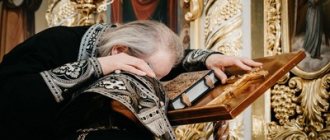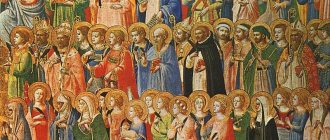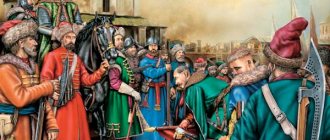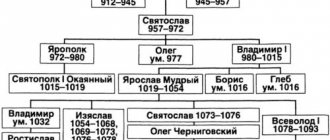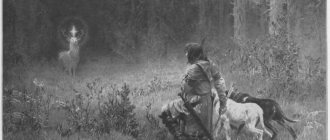The belief is firmly entrenched in people’s minds that anyone who does not love animals can hardly sincerely love people, and in Orthodox texts devoted to relationships with the animal world, they often use the expression “Blessed is he who has mercy on cattle,” which is a free translation of the biblical text: “The righteous has mercy on the souls of his cattle.” The meaning of this expression is interpreted by some theologians as follows: at the Last Judgment, God will ask a person for his attitude towards animals.
Pork is a prohibited animal for consumption in many religions, and in Russian mythology, this animal was also patronized.
Saint Basil the Great is considered the patron saint of pigs, as well as the patron saint of those who have pigs on their farm. On the eve of Vasily's Day (January 1), people were supposed to eat pork, and in some places the tradition of going around houses and collecting pork legs and pies was still preserved. For our ancestors, pork meat was the main treat, starting from Vasiliev's evening until Christmastide.
Saint Basil the Great
Saint Basil the Great was born in Cappadocia (modern Türkiye) around 330.
He came from a noble, rich and very pious family. Vasily spent his childhood on his father's estate in Pontus. As an infant, he suffered a serious illness, from which he was healed by no less than a miracle.
Vasily received his education in Caesarea in Cappadocia. It was probably there that he first met the future Saint Gregory the Theologian. After this, Vasily studied in Constantinople.
Finally, Vasily went to the “center of enlightenment”, Athens. There he replenished his knowledge of literature and philosophy, honed his skills of eloquence and oratory. They say that in addition to this, Vasily mastered astronomy and medicine. In Athens, the Providence of God again brought him together with Gregory the Theologian, who arrived there a little earlier. Being together nurtured and strengthened their friendship. Here Vasily met the future Emperor Julian, the persecutor and destroyer of the Church.
The first steps of Basil the Great in the Christian field
Vasily retired to the deserted place of Pontus. Staying in solitude, he engaged in physical labor, indulged in prayers, reading the Scriptures and writings of the fathers, and ascetic deeds. Vasily's usual food was bread and water. He slept on the ground. Soon his faithful comrade Gregory the Theologian joined him.
The harsh deeds and highly moral life of Christian hermits attracted many imitators and supporters, who, when they came, settled nearby. Vasily took an active part in organizing the religious and moral life of the multiplying communities.
In 368, during a famine caused by drought, Basil, by the power of pastoral exhortation, example and authority, encouraged wealthy citizens to charity, convinced them to open the bins and share with the needy. The estate of Vasily’s mother, who had died by this time, and which he inherited by right of inheritance, also went to help the hungry.
In addition to ascetic and pastoral piety, the activities of Basil the Great were marked by the organization of assistance to the poor, despite the fact that he himself, by his own free will, was one of the poorest people. Among other things, the saint organized almshouses. For example, in Caesarea he set up a hospital and a hospice.
Basil the Great died on January 1, 379, a couple of years before the Second Ecumenical Council. Almost the entire population of Caesarea mourned him. For his merits and the highest holiness of life, Vasily is canonized by the Church and is revered with the name “Great”.
In his ascetic writings, Basil the Great examined and revealed such topics as love for God and neighbors; questions about faith, sin, repentance; about truth and lies; about those who are tempted and those who seduce, about firmness in temptations; about poverty and wealth; about rancor; sorrow at the sight of a brother sinning; about the gifts of God; God's judgment; joy from suffering for Christ; about grief for the dying; human glory; about children and parents, virgins and widows, warriors, sovereigns, etc.
In the field of Orthodox dogma, the most important thing was and continues to be his clearly formulated definition and distinction between the concepts of “essence” and “hypostasis”, necessary for a correct understanding of the dogma of the Holy Trinity. He analyzed the doctrine of the Father, the Son, and the Holy Spirit in his books against the heretic Eunomius, in the essay “On the Holy Spirit.”
Pig farming and pigs
Animals are mentioned quite often in the Holy Scriptures. Perhaps the most famous character is the donkey of the soothsayer Balaam, who spoke in human language, protesting against the beatings. Since then, the catchphrase “Balaam’s donkey” has come into use, which is used in an ironic sense in relation to a usually silent person who suddenly speaks. No less famous are the Gadarene pigs, in which the demons driven out by Christ from the demoniac entered. After a legion of demons entered the herd, the maddened pigs rushed off a cliff into the sea. There is also mention in the Bible of other domestic animals. But these facts are not known to everyone.
which tells the story of the transformation of demons into pigs.
Opening the Orthodox prayer books “For every need,” you can see, for example, the following headings: “Basily the Great is the patron saint of pigs.” It's hard to think of anything more blasphemous. Indeed, there is a popular legend that Saint Basil helps in such a branch of peasant farming as pig farming, that is, he patronizes those people who raise pigs. But for the pigs themselves - this is too much. Unfortunately, many such books are published, and they are in great demand. Thus, Saint Basil is the patron saint of pig farmers and pig farming, but not pigs!
It seemed to me worthy of laughter that someone promised to abstain from pork meat. Therefore, be pleased to teach such people to abstain from foolish vows and vows, and allow the use of things that are infallible. For no creature of God is worthy of disgust, but is received with thanksgiving (1 Tim. 4:4). Therefore, just as a vow is worthy of laughter, abstinence is not necessary.
A pig's belly is not clean, but God has nothing unclean.
Perhaps Saint Basil is not the author of this rule, but simply considered it necessary to write down what seemed prudent and important to him. People always feel what is close to them. Basil the Great had many other rules, but the people labeled him as the patron of pig farming and surrounded their beliefs with legends so that no one would dare to challenge this.
LiveInternetLiveInternet
Hi all! If you are a little interested in religious issues, for the purpose of your own development or for peace of mind, then you know that in Christianity there is the concept of a saint as the patron of a particular phenomenon, type of activity, area and even animals. For example, the patron saint of medicine and the sick is Saint Panteleimon, and the patron saint of students is Saint Great Martyr Tatiana. In addition to well-known patrons, there are other saints whose patronage can sometimes be considered a historical misunderstanding. Although, to each his own, knowledge of such saints will not be superfluous for education
Saint Ambrosius - patron saint of beekeepers
Saint Ambrosius was born into a family of Roman patricians, received a good education, knew Greek, Roman philosophy, and also wrote poetry. There is a legend that when he was still a baby and lying in a cradle, a swarm of bees landed on his face, and after the insects flew away, his whole face was covered in honey. The boy's father considered this a sign from above (I would have thought it too if it were true) that his child would be skilled in public speaking and persuasion. St. Ambrosius later earned the nickname “The Honey-tongued Doctor” for his ability to calm and convince crowds that he was right.
Saint Anthony of Abbey - patron saint of pigs and undertakers
The connection between Anthony of Abbey and pigs is very subtle. During the time when he lived, which was the 3rd-4th century AD, many skin diseases were cured with the help of pork fat, which relieved inflammation and soothed itching. Anthony often treated the sick in this way, and paintings and engravings show him in the company of a pig. Later, people who saw such a picture directly connected Anthony and the pig, and those whose activities were related to raising pigs began to call him their patron. Also, Anthony, at the end of his life, became friends with Saint Paul the Hermit, who buried him after his death. This became the reason for shovel workers to recognize Anthony of Abbey as their patron.
Saint Sebastian - patron of naughty children
Saint Sebastian lived in Milan in the 3rd century and was the captain of the Praetorian Guards - as they would say now, an elite unit guarding the highest-ranking persons. As it turned out later, he was also a well-covered Christian, and secretly converted the Romans to Christianity. What does this have to do with capricious and disobedient children? It turns out that while he was still a captain of the guards, two children were arrested - Marcus and Marcelianus, who spoke poorly of the emperor and were Christians. The children were imprisoned and, under pain of death, were ordered to make sacrifices to the Roman gods to confirm their admiration for the emperor. Sebastian allegedly convinced them not to deviate from the Christian faith, and Marcus and Marcelianus were executed. Afterwards Sebastian himself was arrested, tried and sentenced to death. He was tied to a tree and shot with arrows. After this, the former guardsman miraculously survived and continued to convert his fellow citizens to Christianity. After that, he was sentenced again and beaten to death. Such a contradictory fate...
To be continued…
Orthodox patrons of other animals
Each type of farm animal has its own heavenly patron. Over the course of centuries, traditions gradually developed in Orthodoxy to turn to a certain saint for help when problems arose in certain branches of animal husbandry. In addition to Saints Florus and Laurus, the patron saints of horse breeders, and Saint Blaise, the patron saint of cattle breeders, there are many saints to whom people turn for help regarding the health and growth of animals. So in Orthodoxy it is believed that Saint Basil helps pig farmers, Saint Nikita helps those who raise waterfowl. Even peasants turned to St. George the Victorious to protect their livestock from theft and wild animals.
According to legend, Saint Agafya, the martyr and patroness of livestock, contributed to the successful calving of cows. Saint Onesimus, the sheepfolder, protected the sheep from wolves in the sheepfolds. They also prayed for the well-being and health of livestock to Saint Modest of Jerusalem, the patron saint of domestic animals. The Venerable Martyr Anastasia of Rome is an assistant in the preservation, well-being and healing of livestock.
It is also necessary to remember Saint Maximus the Confessor, Saint Gerasimos of Jordan, the martyr Mamant - the patron saint of small cattle - sheep and especially goats, the holy martyr Tryphon - the patron saint of birds, Saint John of Rila and Saint Anthony the Great, who helped man preserve the health of animals.
Icon "St. Sergius of Radonezh with a bear."
From the lives of Orthodox saints it is known that many of them treated animals with great love. Icons with episodes from the lives of Saints Sergius of Radonezh and Seraphim of Sarov often depict a bear, which the saints fed from their own hands. And on the icon of St. Gerasim of Jordan they always depict a lion sitting at his feet. Leo served the monk as a token of gratitude for healing him from a purulent abscess. Not every church has icons of all the listed Orthodox saints.
You can learn more about the heavenly patrons of animals from the priest when you come with faith and love to an Orthodox church.
Veneration in Rus'
The veneration of Saint Christopher in Rus' begins in the 13th–14th centuries. The image with the head of a dog becomes especially popular: many icons are painted, several churches are built in honor of the martyr.
In 1666, a Church Council was held in Moscow, which approved the reforms of Patriarch Nikon, after which the Old Believer schism began. The depiction of the martyr Christopher with the head of a dog is also prohibited. The Old Believers do not accept the decision of this Council and continue to portray the saint as before.
The ban on the image of St. Christopher with the head of a dog applies to the creation of new images. In some churches and monasteries, ancient icons and paintings were left as they were (Assumption Monastery, Sviyazhsk), and somewhere they painted a new, human face on top of the dog (Savior Transfiguration Cathedral, Yaroslavl).
Sviyazhsk
Yaroslavl
In Western tradition, Saint Christopher is considered the patron saint of pilgrims. The image of the saint can be found on rings and medallions. A pilgrim, while traveling to a holy place, must go with prayer and thus carry Christ within himself. And the image of St. Christopher reminds him of this.


